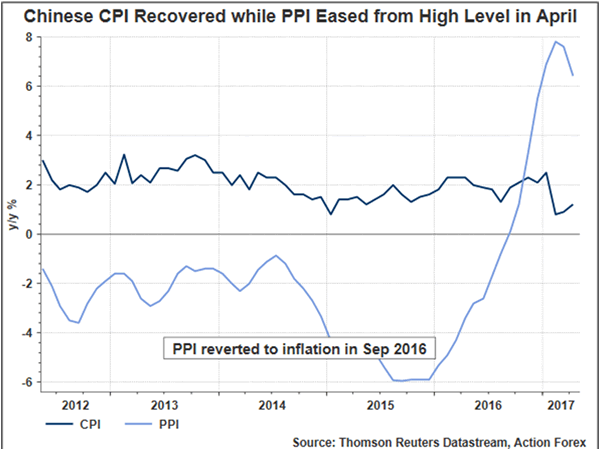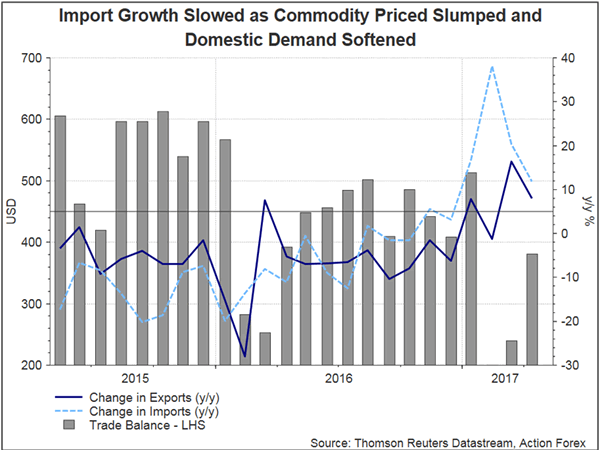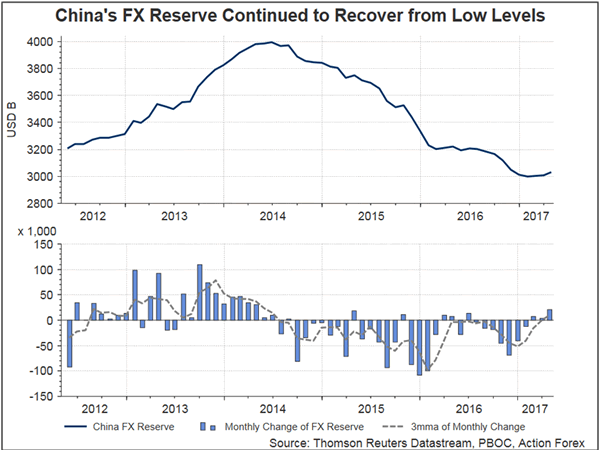China’s headline CPI accelerated to +1.2% y/y in April, from +0.9% a month ago, as mainly driven by the recovery of food disinflation. Food price contracted -3.5% y/y, following a -4.4% drop in March. Nonfood inflation rose to 2.4% y/y in April from +2.3% a month ago. Core inflation (excluding food and energy) improved to +2.1% y/y from +2% in March. Such level should be in line with the government’s target.
PPI moderated to +6.4% in April from +7.6% in March. The deceleration came in more than expectations. A key contributor to the slowdown was commodity prices which slowed further in April as low base effects dissipated. Global prices also pulled back after the strong rally earlier in the year.

Import growth decelerated
China’s trade surplus widened to US$ 38.05B in April, from US$ 23.93B a month ago. This also came in higher than expectations of US$ 35.5B. However, the reading was down -4.5% from the same period last year. Exports expanded +8% y/y while imports were up +11.9%, moderating from the +16.4% and +20.3% growth in March, respectively. Both readings came in below consensus.
Note that this is the first month since last October that China’s headline import growth was worse than expectations. In renminbi terms, exports grew +14.3% y/y, while imports jumped +18.6%, during the period. Both were higher than market expectations.
The market was focused on the import growth, of which the slowdown was mainly driven by diminished commodity demand, especially in iron ore, copper and crude oil. Import growth shrank in both value and volume terms, signaling not only commodity prices, but also domestic demand, were the causes. We believe the Chinese government’s tightening measures has played an important role in causing such phenomenon.

FX reserve rose for a third consecutive month
PBOC’s FX reserve rose for a third consecutive month to US$3.03 trillion in April, marking a +US$21B increase from a month ago. The State Administration of Foreign Exchange attributed the increase to balanced foreign exchange supply and demand and renminibi’s appreciation against US dollar. The market estimated that the reserve increased US$ 15-25B after adjusting for valuation effect.
China’s FX reserve slumped over the past two years after reaching a peak of US$ 3.99 trillion in mid-2014, as the government struggled to rescue the severe depreciation of renminbi by selling foreign currencies. Over 2015 and 2016, the country’s FX reserve contracted –US$ 0.83 trillion while USDCNY soared +12%. The reserved broke below US$ 3 trillion in January 2017 before stabilizing. For the first four months of this year, renminibi’s movement has been steady. Note that PBOC’s FX position and SAFE flow data should also be considered to monitor China’s underlying FX flow situation.

Government to adopt tighter measures
The Chinese government would maintain its ‘prudent and neutral’ monetary policy, adopting tighter measures so as to prevent overheating in certain industries. As such, the overall growth momentum might continue to moderate in coming months, while the financial sector would face challenges over the tighter regulatory measures. Yet, the government would stay cautious to ensure the growth target would be achieved.












